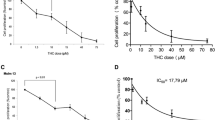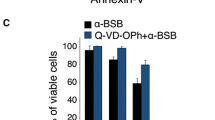Summary
Ethacrynic acid [2,3-dichloro-4-(2-methylene-1-oxobutyl)phenoxyl] acetic acid, is a water-soluble diuretic agent that has been shown to potentiate the in vitro cytotoxicity of chemotherapeutic agents in established cell lines. We used the differential staining cytotoxicity (DiSC) assay to determine whether ethacrynic acid at 1 and 3.3 µM would potentiate the cytotoxicity of nitrogen mustard and/or doxorubicin in primary cultures of hematologic neoplasms from heavily pretreated patients and in normal peripheral blood lymphocytes. At 3.3 µM, ethacrynic acid was toxic to 8 of 24 (33%) tumor specimens studied. In subsequent studies, ethacrynic acid at 1 µM was toxic to only 2 of 54 (4%) tumor specimens. Significant enhancement for doxorubicin or nitrogen mustard was confined to lymphatic malignancies and to normal peripheral blood lymphocytes. Interspecimen variability was observed, with no enhancement in most individual specimens, 2-fold enhancement in some specimens, and 4-fold enhancement in occasional specimens. Clinical trials will be required to determine whether the observed in vitro activity for ethacrynic acid is associated with clinical benefit in unselected or assay-selected patients.
Similar content being viewed by others
References
Ahokas JT, Davies C, Ravenscroft PJ, Emmerson BT (1984) Inhibition of soluble glutathione-S-transferase by diuretic drugs. Biochem Pharmacol 33: 1929–1932
Arrick BA, Nathan CF (1984) Glutathione metabolism as a determinant of therapeutic efficacy: a review. Cancer Res 44: 4224–4232
Bachur NR (1979) Anthracycline antibiotic pharmacology and metabolism. Cancer Treat Rep 63: 817–820
Bird MC, Bosanquet AG, Forskitt S, Gilby ED (1986) Semi-micro adaptation of a 4-day differential staining cytotoxicity (DiSC) assay for determining in vitro chemosensitivity of haematological malignancies. Leuk Res 10: 445–449
Carmichael J, Forrester LM, Lewis AD, Hayes PC, Wolf CR (1988) Glutathione-S-transferase isoenzymes and glutathione peroxidase activity in normal and tumor samples from human lung. Carcinogenesis 9: 1617–1621
Dalton WS, Grogan TM, Meltzer PS, Scheper RJ, Durie BG, Taylor CW, Miller TP, Salmon SE (1989) Drug resistance in multiple myeloma and non-Hodgkin’s lymphoma: detection of P-glycoprotein and potential circumvention by addition of verapamil to chemotherapy. J Clin Oncol 7: 415–424
Dano K (1973) Active outward transport of daunomycin in resistant Ehrlich ascites tumor cells. Biochim Biophys Acta 323: 466–483
Deffie AM, Alam T, Seneviratne C, Beenken SW, Batra JK, Shea TC, Henner WD, Goldenberg GJ (1988) Multifactorial resistance to Adriamycin: relationship of DNA repair, glutathione transferase activity, drug efflux, and P-glycoprotein in cloned cell lines of Adriamycin-sensitive and -resistant P388 leukemia. Cancer Res 48: 3595–3602
Farber CM, Kanganis DN, Liebes LF, Silber R (1989) Antioxidant enzymes in lymphocytes from normal subjects and patients with chronic lymphocytic leukemia: increased glutathione peroxidase activity in CLL B lymphocytes. Br J Haematol 72: 32–35
Hamilton TC, Winker MA, Louie KG, Batist G, Behrens B, Tsuruo T, Grotzinger KR, McKoy W, Young RC, Ozols RF (1985) Augmentation of Adriamycin, melphalan and cisplatin cytotoxicity in drug-resistant and -sensitive human ovarian carcinoma cell lines by buthionine sulfoximine-mediated glutathione depletion. Biochem Pharmacol 34: 2583–2586
Jakoby WB (1978) The glutathione-S-transferases: a group of multifunctional detoxification proteins. Adv Enzymol 46: 383–414
Kramer RA, Greene K, Ahmad S, Vistica DT (1987) Chemosensitization ofl-phenylalanine mustard by the thiol-modulating agent buthionine sulfoximine. Cancer Res 47: 1593–1597
Lewis AD, Hickson ID, Robson CN, Harris AL, Hayes JD, Griffiths SA, Manson MM, Hall AE, Moss JE, Wolf CR (1988) Amplification and increased expression of alpha class glutathione-S-transferase-encoding genes associated with resistance to nitrogen mustard compounds. Proc Natl Acad Sci USA 85: 8511–8515
Lutzky J, Astor MB, Taub RN, Baker MA, Bhalla K, Gervasoni JE Jr, Rosada M, Stewart V, Krishna S, Hindenburg AA (1989) Role of glutathione and dependent enzymes in anthracycline-resistant HL60/AR cells. Cancer Res 49: 4120–4125
Mannervik B (1985) The isoenzymes of glutathione-S-transferase. Adv Enzymol 57: 357–417
Masuda H, Ozols RF, Lai G, Fojo A, Rothenberg M, Hamilton TC (1988) Increased DNA repair as a mechanism of acquired resistance tocis-diamminedichloroplatinum(II) in human ovarian cancer cell lines. Cancer Res 48: 5713–5716
Miller TP, Grogan TM, Spier CM, Salmon SE, Dalton WS (1989) High-dose verapamil infusion added to chemotherapy reverses drug resistance in lymphoma patients in relapse (abstract). Proc Am Soc Clin Oncol 8: 252
Moran EM, Nagourney RA, Ottenheimer EJ, Mahutte KC, Weisenthal LM (1988) Reversal of acquired drug resistance with lidocaine and verapamil: a phase I study (abstract). Proc Am Assoc Cancer Res 29: 218
Nagourney RA, Messenger JC, Kern DH, Weisenthal LM (1989) In vitro enhancement of doxorubicin and nitrogen mustard cytotoxicity in drug-resistant human neoplasms by ethacrynic acid (abstract). Proc Am Assoc Cancer Res 30: 574
Plooy ACM, Dijk M van, Berends F, Lohman PHM (1985) Formation and repair of DNA interstrand cross-links in relation to cytotoxicity and unscheduled DNA synthesis induced in control and mutant human cells treated withcis-diamminedichloroplatinum (II). Cancer Res 45: 4178–4184
Riordan JR, Ling V (1985) Genetic and biochemical characterization of multidrug resistance. Pharmacol Ther 28: 51–71
Russo A, DeGraff W, Friedman N, Mitchel JB (1986) Selective modulation of glutathione levels in human normal versus tumor cells and subsequent differential response to chemotherapy drugs. Cancer Res 46: 2845–2848
Safa AR, Glover CJ, Meyers MB, Biedler JL, Felsted RL (1986) Vinblastine photoaffinity labeling of a high-molecular-weight surface glycoprotein specific for multidrug-resistant cells. J Biol Chem 261: 6137–6140
Schisselbauer JC, Silber R, Papadopoulous FP, LaCreat FP, Tew KD (1989) Characterization of lymphocyte glutathione-S-transferase isozymes in chronic lymphocytic leukemia (abstract). Proc Am Assoc Cancer Res 30: 513
Smith MT, Evans CG, Doane-Setzer P, Castro VM, Tahir MK, Mannervik B (1989) Denitrosation of 1,3-bis(2-chloroethyl)-1-nitrosourea by classmu glutathione transferases and its role in cellular resistance in rat brain tumor cells. Cancer Res 49: 2621–2625
Somfai-Relle S, Suzukake K, Vistica BP, Vistica DT (1984) Glutathione-conferred resistance to antineoplastics: approaches toward its reduction. Cancer Treat Rev 11 [Suppl A]: 43–54
Suzukake K, Vistica BP, Vistica VT (1983) Dechlorination ofl-phenylalanine mustard by sensitive and resistant tumor cells and its relationship to intracellular glutathione content. Biochem Pharmacol 32: 165–167
Tew KD, Clapper M (1988) Glutathione-S-transferase and anti-cancer drug resistance. In: Mechanisms of drug resistance in neoplastic cells. Academic Press, New York, pp 141–159
Tew KD, Kyle G, Johnson A, Wang AL (1985) Carbamoylation of glutathione reductase and changes in cellular and chromosome morphology in a rat cell line resistant to nitrogen mustard but collaterally sensitive to nitrosoureas. Cancer Res 45: 2326–2333
Tew KD, Bomber AM, Hoffman SJ (1988) Ethacrynic acid and piriprost as enhancers of cytotoxicity in drug-resistant and sensitive cell lines. Cancer Res 48: 3622–3625
Tewey KM, Rowe TC, Yang L, Halligan BD, Liu LF (1984) Adriamycin-induced DNA damage mediated by mammalian DNA topoisomerase II. Science 226: 466–468
Weisenthal LM, Dill PL, Finklestein JZ, Duarte TD, Baker JA, Moran EM (1986) Laboratory detection of primary and acquired drug resistance in human lymphatic neoplasms. Cancer Treat Rep 70: 1283–1295
Weisenthal LM, Su Y, Duarte TE, Dill PL, Nagourney RA (1987) Perturbations of in vitro drug resistance in human lymphatic neoplasms by combinations of putative inhibitors or protein kinase C. Cancer Treat Rep 71: 1239–1243
Author information
Authors and Affiliations
Additional information
This work was supported in part by a grant from the Memorial Foundation of Long Beach
Rights and permissions
About this article
Cite this article
Nagourney, R.A., Messenger, J.C., Kern, D.H. et al. Enhancement of anthracycline and alkylator cytotoxicity by ethacrynic acid in primary cultures of human tissues. Cancer Chemother Pharmacol 26, 318–322 (1990). https://doi.org/10.1007/BF02897285
Received:
Accepted:
Issue Date:
DOI: https://doi.org/10.1007/BF02897285




